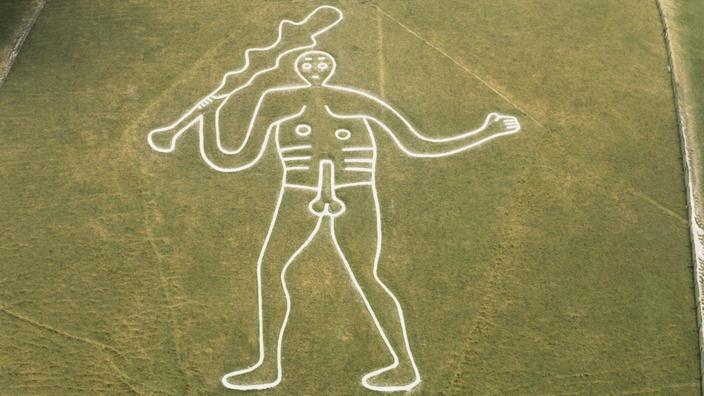Although visible from the floor of the cows, the strange and immodest figure engraved on the side of a hill in Dorset, in the United Kingdom, is revealed in all its splendor only as the crow flies, or seen from a drone. The chalk furrows which smear the grassy surface of the site, located on the outskirts of the village of Cerne Abbas, then take the form of a formidable naked figure, a club brandished in the right hand, the penis erect, the left palm outstretched. and his face frozen in a fierce expression. Almost 55 meters long, this geoglyph known since at least the end of the 17th century has long questioned specialists. What did he represent? A prehistoric entity of fertility? An Iron Age Hercules? A thousand miles from being an ancient engraving that would have come down to us from the depths of the ages,this motif would rather date from the end of the High Middle Ages, indicated in recent days a team of British archaeologists. A shattering hypothesis, which had until then hardly been considered.
Read also: In the United States, Native American petroglyphs covered with white supremacist graffiti
To identify this refined chronology, the experts proceeded to a luminescence dating of the grains of sand taken from the oldest layers of the gigantic pattern, almost one meter below the surface. The technique, which makes it possible to determine the last period in which certain minerals were exposed to the sun, was able to demonstrate that the engraving of Cerne Abbas had been carried out between the years 700 and 1100 AD. AD, that is to say towards the end of the Saxon era of the British island, which ended in 1066 with the Norman conquest. That is to say a completely different time from other figures of the same type located in England, such as the White Horse of Uffington, Oxfordshire, which could date from the end of the Bronze Age.
“This is not what we expected.
Many archaeologists and historians believed it to be prehistoric or post-medieval, but not medieval.
Everyone was wrong, ”
said geoarchaeologist Mike Allen who was able to excavate the site in a statement.
"No one, in all the debates, discussions, meetings and academic publications, has ever considered that it was this date,"
he also confided in astonishment to the
New Yorker
.
The giant of Cerne Abbas reset quite recognizable from the very surface of the hill.
National Trust
A Saxon deity?
Rather than clarifying the enigma of the titan of Dorset, this discovery raises even more the question of the apparent indifference that the residents would have kept for this remarkable work, located on the immediate edge of the village. As the site's specialists recall, the first written mention of the giant dates only from 1694, while a monastery was founded at Cerne Abbas in 987 and the dating of another sample taken indicates some work or at least an alteration. of the site around 1560.
Also during modern times, the cartographer and antiquarian John Norden made no mention of the geoglyph either in the work he carried out in 1617 in the region, although the structure would probably not have failed to interest him. .
What happened to explain this silence of the archives?
Read also: An exceptional necropolis from late Antiquity discovered in Cambridge
"It may have been created very early, at the end of the Saxon period, before being covered by the lawn and forgotten,"
suggested archaeologist Martin Papworth, who believes that the giant probably did not was rediscovered before the 17th century.
"This would explain why it does not appear in the archives of the abbey or in the Tudor records"
. The hypothesis also allows to rule out one of the most absurd leads on the origin of the colossus, according to which it would be a caricature of Oliver Cromwell, the Lord-protector who presided, from 1653 to 1658, the only republican experience in England. If he was not a Celtic god, let alone Cromwell, what was the titan of Cerne Abbas? For British researchers, the Saxon dating advanced by laboratory analyzes makes it possible to rehabilitate an old track: that of a representation of a Saxon god named Heil, or Helith. According to written sources, the establishment of the monastery at Cerne Abbas in 987 - just 300 meters from the giant hill - was aimed precisely at better controlling a local cult of this pagan entity.
Read also: A Bronze Age sword exhumed in very good condition from a Danish archaeological site
The proposal is attractive to say the least and now a little better supported by a rather favorable chronology.
Already partly Christian under the Late Roman Empire, Great Britain was occupied from the 5th century by the pagan Anglo-Saxons who established several kingdoms on the island.
It was not until the end of the 6th century that Pope Gregory the Great organized missions meant to convert the various rulers of the island.
This missionary enterprise continued throughout the 7th century, not without some waves of pagan reactions, to which the giant of Cerne Abbas, located in the south of the country, twenty kilometers from the English Channel, could justly testify. However, it remains difficult to determine whether the figure drawn near the village did indeed have any link with the cult of fertility, for lack of precise knowledge on the Saxon god concerned, whose link with the engraved motif remains only a conjuncture. . His nudity could, for example, have a heroic character, as is often the case in ancient art. Better dated, the colossus of Cerne Abbas remains decidedly no less mysterious and impenetrable.

